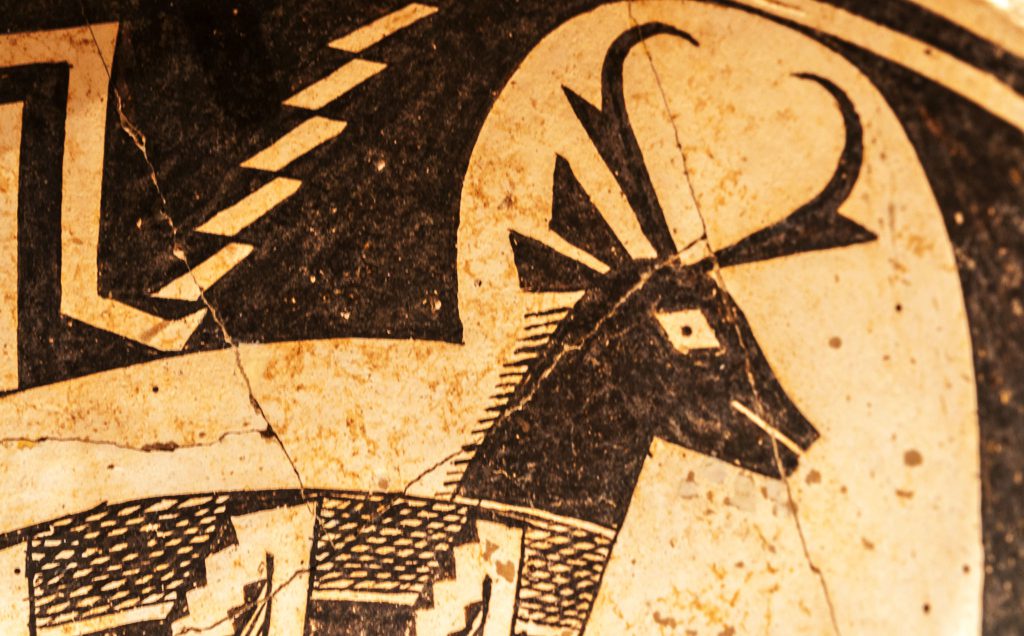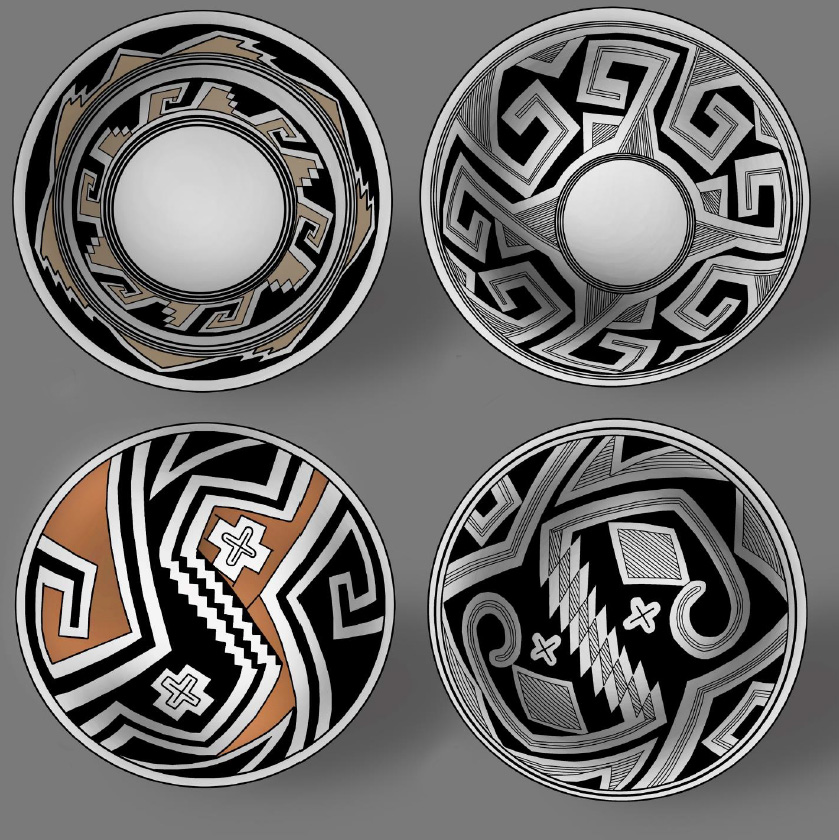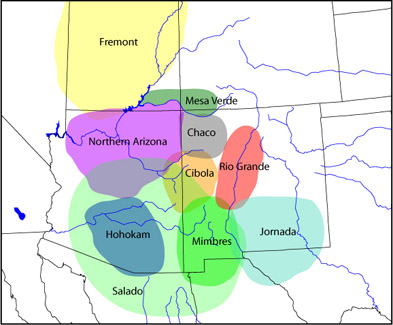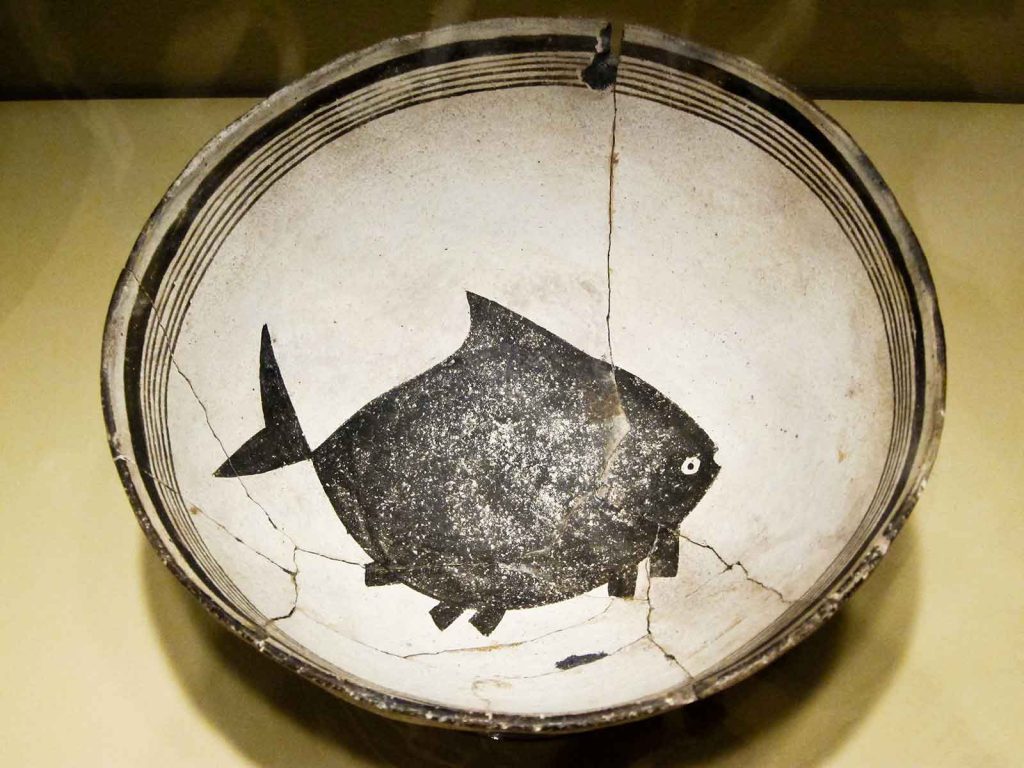The Hidden Color Code in Mimbres Pottery

Classic Mimbres pottery is famous and admired today for its beautiful, minimalist style. Elegant geometric patterns and figurative drawings grace these pots with a strikingly limited color palette: black and white, and sometimes red and brown. But it turns out that ancient Southwestern potters may have pointed to color in their pieces—in code.
In the U.S. Southwest, after the year 500 or so, symbols on decorated pottery became one of the main ways in which people conveyed and permanently recorded social and religious messages—including for the Mimbres tradition, centered on the Mimbres Valley in present-day New Mexico around 1000. Some of the symbolism lends itself to easy interpretation by contemporary anthropologists: masked, dancing figures may represent katsinam, deified ancestors who bring rain and social order; one pot shows a pregnant woman carrying home a deer from the hunt, likely speaking to gender roles and cooperation. There are many images of animals, which might represent individuals, personality traits, clan associations, spirits—or just animals. Geometric patterns can be harder to decipher.
The limited color selection on these striking pots may have been partly an aesthetic choice, but it also seems to have been a necessity. These artists simply didn’t have many colored pigments that would survive the firing process used to harden vessels: only black, white, and an earthen tone ranging from brown to red were available. Most Mimbres vessels were “slipped” white first, with black designs painted on afterward.
The lovely blue-green of turquoise, for example, a stone for which this region is famous, could not be permanently integrated into pottery. Blue-green paint made from pulverized rock could be applied after firing, but it would quickly fade or flake away, making it a disappointing option only rarely used.
So how could those early potters represent color?
Interestingly, a similar problem was encountered by archaeologists of the 19th and early 20th centuries who tried to convey the color of their archaeological finds in the black-and-white medium of academic journals’ printed pages. Their solution? They arbitrarily selected patterns as proxies for colors. Dots might represent red, for example, or cross-hatching might signify brown. Luckily for the reader, these simple codes were spelled out in legends.
It turns out that ancient Southwestern potters did the same; though without a written language to convey a key, researchers have had to use some sleuthing to crack their code.
In the 1970s, American art historian Jerry “J.J.” Brody speculated that 11th- and 12th-century potters in the Chaco region of what is today New Mexico used black hachure—closely spaced, parallel lines—on a white background as a proxy for the color blue-green. The Chaco culture was centered on Chaco Canyon, but it spanned the Four Corners area of Utah, Colorado, Arizona, and New Mexico.
Brody had noticed some striking similarities between black-on-white designs on pottery and more colorful designs in other media, such as stone mosaics and painted boards, where color was easier to apply and longer-lasting. The designs were similar, but where the mosaics had turquoise, the pottery had hachure.
In 2003, archaeologist Stephen Plog of the University of Virginia tested this idea, comparing the use of hachure on pots to the use of blue-green on more than 50 objects featuring color. His findings supported Brody’s idea: Hachure seemed to represent turquoise.
As archaeologists who are interested in large-scale social processes, we wondered if this strategy went further than just the Chacoan culture. What about Classic Mimbres society, for example, which flourished during roughly the same time (1000–1130) and just about 600 kilometers to the south?
Chacoan and Mimbres communities—largely contemporaneous and not terribly far apart—had shared ideas and practices that were at once similar, yet different. Both built ceremonial structures called great kivas, for example, although those at Chaco were round and Mimbres ones were generally rectangular. Both built large, apartment-like masonry structures called pueblos, but while Chacoan pueblos reached skyward, Mimbres pueblos expanded sideways.
Perhaps the best-known Mimbres crafts are their stunning black-on-white vessels. Most of their designs are geometric, but some include figurative images of animals, people, and fantastical creatures engaged in all manner of behaviors. Some of them, like the Chacoan pots, had hachure.
One of us, Will Russell, has worked with an online collection of more than 9,000 images of Mimbres ceramics called the Mimbres Pottery Images Digital Database, first as a research associate and currently as a board member for the project. We were well-equipped to do some comparisons of our own.
For our investigation, we began by following Plog’s approach, comparing hachured vessels to other artifacts. Unfortunately, few painted, non-ceramic artifacts have been recovered from the Mimbres region—probably fewer than 50 that can be confidently traced to Mimbres deposits. Such a small sample is not ideal for a research project, but it is enough to do a small analysis.
Take, for example, a small, mosaicked plaque with a flower-like motif, the petals of which were fashioned from turquoise, found in a cave in the Mimbres area. A few Mimbres pottery bowls have similar flower motifs. But the hachure we found in those black-and-white images on the pottery corresponds not with the plaque’s blue-green, as with Chacoan pottery, but with the color red—the center of the flower, not its petals.
Fish are the most commonly depicted subject matter in Mimbres pottery, and many images of them feature hachure. Again, wooden carvings of similar fish, and other artifacts, have red where the pottery has hachure.
Near the end of the Mimbres cultural tradition, another type of pottery was produced: Mimbres polychrome, made by adding a third color—frequently a shade of yellow to red—to vessel designs. The placement of yellow or red elements in Mimbres polychrome vessels was stylistically analogous to the incorporation of hachured elements in Mimbres black-on-white vessels.
Archaeologists and local communities generally agree that Mimbres populations contributed to today’s Puebloan communities of the Southwest. Interestingly, and uniformly across the pueblos for the past century or so, blue-green has been symbolically linked to maleness. In Mimbres pottery, however, we have found that hachure was divided equally between male and female human depictions, whereas in pronghorn motifs, hachure was overwhelmingly associated with females.
There is much more work to be done to crack ancient Southwestern color codes. There are other styles of marking on Ancestral Puebloan pottery that could have meaning or correlation to colors. Sikyatki polychrome, for example, crafted a little later than Mimbres polychrome in what is today northeastern Arizona, includes some vessels that feature an innovative pattern of splattered paint achieved by blowing paint through a reed. Playas red, a red-slipped form of Chihuahuan pottery, features incised patterns that range from herringbone to something reminiscent of a basket weave.
Perhaps Chacoan and Mimbres societies also saw themselves in a complementary light.
Interestingly, the ancient Egyptians used colors like bright blue in their pottery several thousand years earlier than when Ancestral Puebloans were making their pots. Different ancient cultures around the world had access to different minerals and technologies, and had different priorities and subtleties when it came to nonverbal communication. Perhaps other societies in history may also have used patterns or texture to symbolize color in their black-and-white arts. Cracking the symbolism in their art may help reveal something more about those cultures.
Our finding that the color code in Mimbres pottery seems different from that in Chacoan society may have interesting implications. Throughout the Native American Southwest today, blue-green and yellow are paired in ceremonial and cosmological contexts, both contrasting and complementing each other. The two colors, like the black and white of yin and yang, are used to show stark contrasts—male and female, water and maize, sky and earth, sun and moon, underworld and upper world—that work together to form a successful whole.
Perhaps, we speculate, Chacoan and Mimbres societies also saw themselves in a complementary light.




































